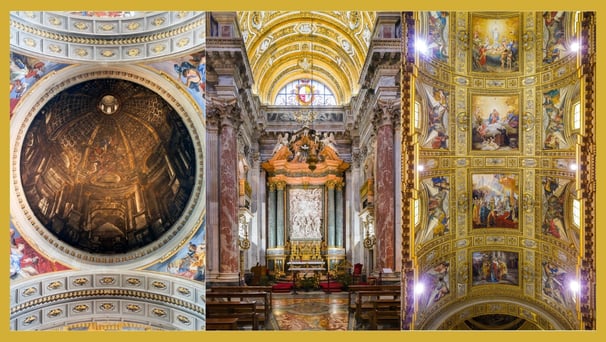Sacred Sites to Visit in Rome During the 2025 Jubilee
Contents
Church of Saint Ignatius of Loyola at Campus Martius
Church of Saint Agnes at the Circus Agonalis
Sant'Andrea della Valle Basilica
Conclusion
Rome, with its extensive religious heritage, beckons pilgrims to explore numerous sacred places beyond the renowned Jubilee Basilicas. These sites are not merely venues for prayer but also superb repositories of art and history, showcasing centuries of devotion and artistic splendor. In this article, we'll delve into three churches brimming with allure and artistic grandeur: Saint Ignatius of Loyola at Campus Martius, Saint Agnes at the Circus Agonalis, and Sant'Andrea della Valle, each a must-visit during the 2025 Jubilee.


Church of Saint Ignatius of Loyola at Campus Martius
Constructed in 1626, the Church of Saint Ignatius of Loyola stands as a testament to the mastery of perspective and artistic illusion. Designed by Andrea Pozzo, the church is renowned for its False Dome—a 17-meter diameter canvas created to address the absence of an actual dome. This masterpiece produces an astonishing optical illusion that transforms a flat surface into a seemingly three-dimensional space, ingeniously designed to evoke wonder and expand the believer's sense of the infinite, thereby ingeniously overcoming the architectural constraints of that era
The church’s vault features the imposing fresco of the Glory of Saint Ignatius, where a beam of light from Christ’s side illuminates the saint, casting reflections across the then-known continents of Europe, Asia, Africa, and America, depicted through allegorical figures. The effect is so realistic it creates the illusion of endless space. This Baroque marvel captivates visitors, bridging faith with art in a profound experience. To fully appreciate this illusion, the church provides mirrors or designated viewing spots marked by yellow discs on the floor, offering optimal views of this fresco.
The Church of Saint Ignatius of Loyola is a distinguished example of Baroque artists’ genius in creating visually impactful spaces where architecture and painting splendidly converge. It invites pilgrims not only for prayer but also for the contemplation of art's grandeur as an expression of the divine.
Church of Saint Agnes at the Circus Agonalis
Positioned in the historically significant Piazza Navona, the Church of Saint Agnes at the Circus Agonalis (Chiesa di Sant'Agnese in Agone) is a prime example of Roman Baroque architecture. Initially conceptualized by Girolamo Rainaldi, the church was later re-envisioned by the illustrious architect Francesco Borromini. Its interior, designed in the shape of a Greek cross, is adorned with gilded stuccos and rich decorations that embellish the vaults and walls, making it a stunning showcase of Baroque craft
One of the most renowned pieces inside the church is the tomb of Innocent X Pamphili, the church's patron. The dome, adorned with frescoes by Ciro Ferri and Sebastiano Corbellini, portrays Saint Agnes ascending into the Glory of Paradise, a scene that captivates with its dynamism and luminous use of light. The altars are elegantly framed by columns of red Cottanello marble, quarried from the Lazio region for its beauty and durability, lending a touch of majesty to this extraordinary sanctuary. Noteworthy among the artworks are the statues of Saint Agnes and Saint Sebastian, skillfully crafted by Ercole Ferrata and Pier Paolo Campi
The Church of Sant'Agnese in Agone transcends its role as a mere place of worship; it is a treasure trove of stories and legends that amplify its allure. One finds amidst these tales the legends associated with the Fountain of the Four Rivers (Fontana dei Quattro Fiumi), positioned directly in front of the church, a vital part of Rome's cultural legacy that renders this site even more captivating. Common lore credits these myths to the rivalry between Gian Lorenzo Bernini and Francesco Borromini. According to one popular myth, the statue of the River Plate raises its arm as though it fears the church might collapse, while the statue of the Nile covers its face, unable to gaze upon the church. These tales, however, are mythical since the fountain was completed from 1648 to 1651, well before Borromini commenced work on Sant'Agnese in 1653. In truth, the Nile's face is veiled because its sources remained undiscovered at the time
The church's position in the iconic Piazza Navona enhances the visitor experience considerably. Renowned for its distinctive shape and ornate fountains, Piazza Navona is one of the most frequented sites by pilgrims and tourists, where the Church of Sant'Agnese in Agone stands as a beacon of faith amidst extraordinary urban beauty.
Sant'Andrea della Valle Basilica
Started in 1590 and completed in 1650, the Sant'Andrea della Valle Basilica is a stellar example of Roman Baroque architecture, boasting the second largest dome in Rome after Saint Peter's. The basilica is celebrated for its spectacular frescoes and sculptures. The dome, a creation of Carlo Maderno, features frescoes by Giovanni Lanfranco, depicting the Assumption of the Virgin. This breathtaking fresco captures angelic figures in ethereal suspension, as if floating through space
The transept of the basilica hosts frescoes by Domenichino, including the renowned Crucifixion of Saint Andrew and The Calling of the Brothers Peter and Andrew, positioned in the apse and the apsidal conch, respectively. The side chapels, such as the Barberini chapel, are adorned with works by Pietro and Gian Lorenzo Bernini, adding further splendor to this sacred site. The funerary monument of Pope Pius II, located in the nave, signifies another significant historic and artistic site. Moving from the vibrant historical narratives of Sant’Agnese in Agone, another architectural marvel stands out in Rome’s ecclesiastical landscape: the Basilica of Sant’Andrea della Valle, which echoes the grandeur of Italian Baroque art and architecture
The Sant'Andrea della Valle Basilica is a sanctuary of profound spirituality and significant artistic value. Its majestic dome and the ornate richness of its frescoes rank it among the most awe-inspiring churches in Rome. Works by pivotal artists such as Domenichino and Bernini make this basilica an essential stop for anyone wishing to delve into the splendor of Baroque art. Its central location facilitates inclusion in the pilgrimage route, thereby deepening the spiritual voyage with moments of contemplation before some of the most esteemed masterpieces of sacred art.
Conclusion
The trio of churches — Saint Ignatius of Loyola at Campus Martius, Saint Agnes at the Circus Agonalis and Sant'Andrea della Valle Basilica — provide pilgrims not only a profound spiritual experience but also immerses them into Rome's rich tapestry of art and history. Each church stands as a distinctive testament to the artistic prowess and architectural ingenuity of bygone eras, adorned with frescoes, sculptures, and legends that enhance the visitor's journey. Visiting these sanctuaries during the 2025 Jubilee connects one to the artistic and cultural opulence of the city, enriching the pilgrimage with enduring masterpieces that have withstood the test of time
Rome, with its concealed marvels, remains a beacon of faith and beauty that consistently captivates its visitors. Every corner of the city narrates a tale, and each church contributes a significant chapter to this epic. A visit to these sites not only deepens one's faith experience but also uncovers the artistic soul of Rome, where art and spirituality are inextricably linked.
The 2025 Jubilee invites a profound journey through faith, history, and culture, inspired by the enduring beauty and spiritual heritage of Rome's sacred sites.
Drop us a line
Follow us
Discover the Jubilee
Experience the Jubilee
Jubilee locations
Get ready for the Jubilee
Rome and the Jubilee
